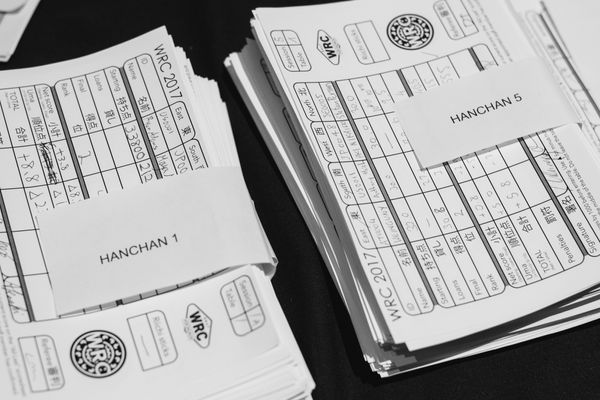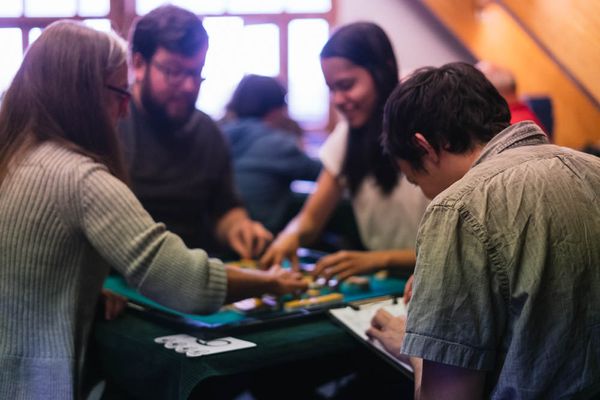Tile History - The man suit.
Today we take a look back to why the man or wan suite looks like it does. Or, to put it in another way - where do the numbers come from, and why do they look like they do?
Okay, a bit of a history lesson. Most of our knowledge of Chinese characters come from what is commonly called "oracle bones" - up until late 19th century they were used as an ingredient in medicine, and were then called "dragon bones." In 1899, an author named Liu E went to the apothecary to get some medicine for his sick friend, and noticed that the "dragon bones" that got turned into bone powder contained inscriptions that looked like Chinese characters, albeit slightly (quite) different. Lots of stuff happened, but in the end they (Liu E and his friend) found a massive pile of dirt where poor farmers used to dig for "dragon bones" - in Xiaotun (just outside Anyang). The reason they're called "oracle bones" is that because they were used when the king of Shang wanted to contact his ancestors, that were resident in the heaven around Shangdi. The oracles polished a piece of bone - usually a shoulder bone from an ox, or the bottom shield from a turtle, and drilled rows of grooves in it. Then they shouted with a loud voice the king's question to his ancestors, and lowered at the same time a heated bronze staff into the grooves. The shell or bone cracked from the heat, with a loud noise, and that was a sign the animal "spoke." In the cracks the oracles could read the answer to the question. Often they'd carve both question and answer into the bones or shells that had been used, and at times whether or not the prophecy came true or not. Then they were archived.
Why the Chinese and Japanese write up to down, and right to left, could have started at this age, at least they tended to write the questions in that order. No matter. (The character "to predict" or "to foretell" is卜 and was pronounced "puk" in ancient times. Today it'd be pronounced "bǔ" or something similar. It also means "fortune telling" in Japanese.)
The Shang Dynasty perished roughly 1100 years BCE. Buildings, archives and temples deteriorated, and when the Huan river flooded everything got buried beneath a layer of yellow mud. For three thousand years.
I think that's enough of that part of the history for now. You're all mahjong freaks, so we'll get right to the numbers, shan't we?
In Europe we adapted the Arabic numerals quite early, whereas the Chinese has, during their entire history, to the beginning of the 20th century, used their own system. It seems to have started from a system of thin, 15 centimetres long bamboo shafts, that you put in different formations on a flat surface, and had them represent numbers.
The oldest "counting laths" (or "strip of wood" if you will), that we know of, were found in the beginning of 1970, in a couple of Han-graves. But counting laths are mentioned in several places in literature from 400 BCE, and seem to have been used during the Shang dynasty as well. They were, back then, already using the decimal system. Time for a picture:


The system might seem primitive, but from a mathematical point of view it's more advanced than the systems that were used elsewhere in the world; Babylon, Egypt, Greece and Rome. Consider, for example, the number 19 - in Roman it'd be written as 20-1 (IXX), 50 would be L, and 100 would be C (I'm particularly fond of numbers like 74 - LXXIV, or 50+20-1+5). The Chinese, however, had no problems writing any number, and just from 9 numbers (either standing or lying down), at that. They were probably first in the world with an absolute position system for numbers, at least according to Needham. Some time during the Ming dynasty, the two systems were combined, and a single system was put in use. I'm too lazy to draw it, but I really should.

The "counting laths" (I really don't know what to call them) were used for over 2,000 years, but when the abacus came during the 14th century, their time was up.
ENOUGH HISTORY. Let's get on with it.
一 二 三
These has looked the same since the time of the oracle bones. It's quite probable that their form is based on the "counting laths."
四
Four was once written with four horizontal lines, but around 200 BCE they started to replace it with a more square-ish form, that later became the standard. Some theories has this down to the fact that four is an even number and easy to split in the middle, and want the symbol to say just that, but I think that's bollocks personally.
五
This number, as well, was written with horizontal lines on the oracle bones, but even back then they had started to group up the lines - except the topmost and bottommost ones - into a cross (X). Imagine, if you will, a regular X with lines going on top of it, and on its bottom part, and you can see how it'd look. This, I actually am too lazy to draw. This X-like thing is the basis for the symbol that we now know.
六 七 八 九 十
(I know that 10 isn't used in mahjong, shush you.) The numbers six, seven, eight, nine and ten are discussed quite a lot, but there's no real explanation for them. They should, logically - like the numbers one to five - be based on the "counting laths", and the symbols for six, seven and ten were, in their oldest forms, written with completely straight lines, of the same length and kind as those used in signs one to five. Indicating that they have the same source.
The only problematic numbers are actually eight and nine. In both signs' original forms there are soft lines, hardly suitable for the "counting laths" - because the "counting laths" were, as far as we know, stiff and of the same length. We can only hope that an explanation will arrive, some day.
There's one more "number" left. It's not so much a number as it is an "order."
萬 - 10,000's
This little pearl is actually a lot more interesting than you might think. It's a loan word. The symbol actually means, and gives an excellent picture of, a scorpion. You can see its claws, and the tail. Both of the words - the word for scorpion and the word for 10,000's (wan), were pronounced the same in early times. For some reason they let the symbol for scorpion also stand for "10,000", "countless" and "myriads."
That's it for today. I don't know when I'll next update - there aren't really that many symbols used in mahjong - but surely you've already added this blog to your RSS feed.



